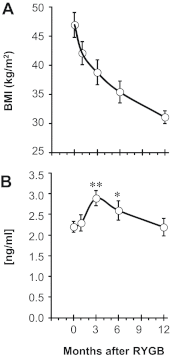Low circulating adropin concentrations with obesity and aging correlate with risk factors for metabolic disease and increase after gastric bypass surgery in humans
- PMID: 22872690
- PMCID: PMC3462944
- DOI: 10.1210/jc.2012-2194
Low circulating adropin concentrations with obesity and aging correlate with risk factors for metabolic disease and increase after gastric bypass surgery in humans
Abstract
Context: Mouse studies suggest that adropin, a peptide hormone, is required for metabolic homeostasis and prevention of obesity-associated insulin resistance. Whether obesity and insulin resistance are associated with low plasma adropin levels in humans is not known.
Objectives: Our objective was to investigate the hypothesis that obesity and indicators of insulin resistance are associated with low adropin levels and determine whether weight loss regulates adropin levels.
Design and participants: Plasma was obtained from 85 female [age 21-67 yr, body mass index (BMI) 19.4-71.5 kg/m2] and 45 male (age 18-70 yr, BMI 19.1-62.6 kg/m2) volunteers for other clinical studies. The impact of Roux-en-Y gastric bypass was investigated in 19 obese females (BMI 37-65 kg/m2) using samples collected at baseline and 1-12 months after surgery.
Results: Adropin levels correlate negatively with BMI (r=-0.335, P<0.001) and age (r=-0.263, P=0.003). Age-adjusted adropin levels are higher in males [4.1 ng/ml; 95% confidence interval (CI)=3.6-4.6 ng/ml] than females (3.0 ng/ml; 95% CI=2.6-3.4 ng/ml) (P=0.001). In all subjects, lower age-adjusted adropin levels were observed in overweight (3.3 ng/ml; 95% CI=2.8-3.8 ng/ml, P=0.033) and obese (2.7 ng/ml; 95% CI=2.1-3.3 ng/ml, P=0.001) compared with healthy-weight subjects (4.1 ng/ml; 95% CI=3.6-4.5 ng/ml). This effect was gender specific (weight category×gender, P<0.001) and was observed in males only. Aging and diagnosis with two or more metabolic syndrome risk factors was associated with low adropin levels, irrespective of sex. Adropin concentrations increased after Roux-en-Y gastric bypass, peaking 3 months after surgery (P<0.01).
Conclusions: Although males exhibit higher adropin levels that are reduced by obesity, aging and markers of insulin resistance are associated with low plasma adropin irrespective of sex.
Figures




References
-
- Kumar KG, Trevaskis JL, Lam DD, Sutton GM, Koza RA, Chouljenko VN, Kousoulas KG, Rogers PM, Kesterson RA, Thearle M, Ferrante AW, Jr, Mynatt RL, Burris TP, Dong JZ, Halem HA, Culler MD, Heisler LK, Stephens JM, Butler AA. 2008. Identification of adropin as a secreted factor linking dietary macronutrient intake with energy homeostasis and lipid metabolism. Cell Metab 8:468–481 - PMC - PubMed
-
- Lian W, Gu X, Qin Y, Zheng X. 2011. Elevated plasma levels of adropin in heart failure patients. Intern Med 50:1523–1527 - PubMed
-
- Lovren F, Pan Y, Quan A, Singh KK, Shukla PC, Gupta M, Al-Omran M, Teoh H, Verma S. 2010. Adropin is a novel regulator of endothelial function. Circulation 122:S185–S192 - PubMed
Publication types
MeSH terms
Substances
Grants and funding
LinkOut - more resources
Full Text Sources
Other Literature Sources
Medical
Molecular Biology Databases
Research Materials

